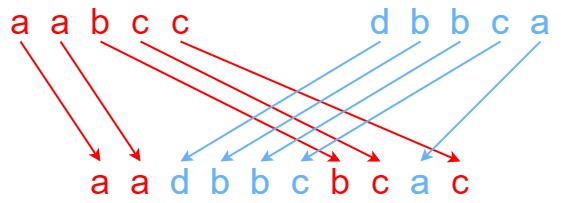Problem Description
Given strings s1, s2, and s3, find whether s3 is formed by an interleaving of s1 and s2.
An interleaving of two strings s and t is a configuration where s and t are divided into n and m substrings respectively, such that:
s = s1 + s2 + … + snt = t1 + t2 + … + tm|n - m| <= 1- The interleaving is
s1 + t1 + s2 + t2 + s3 + t3 + …ort1 + s1 + t2 + s2 + t3 + s3 + …
Note: a + b is the concatenation of strings a and b.
Example 1:

Input: s1 = “aabcc”, s2 = “dbbca”, s3 = “aadbbcbcac” Output: true Explanation: One way to obtain s3 is: Split s1 into s1 = “aa” + “bc” + “c”, and s2 into s2 = “dbbc” + “a”. Interleaving the two splits, we get “aa” + “dbbc” + “bc” + “a” + “c” = “aadbbcbcac”. Since s3 can be obtained by interleaving s1 and s2, we return true.
Example 2:
Input: s1 = “aabcc”, s2 = “dbbca”, s3 = “aadbbbaccc” Output: false Explanation: Notice how it is impossible to interleave s2 with any other string to obtain s3.
Example 3:
Input: s1 = "", s2 = "", s3 = "" Output: true
Constraints:
0 <= s1.length, s2.length <= 1000 <= s3.length <= 200s1,s2, ands3consist of lowercase English letters.
Follow up: Could you solve it using only O(s2.length) additional memory space?
Difficulty: Medium
Tags: string, dynamic programming
Rating: 94.33%
Solution Explanation
The solution uses dynamic programming to solve this problem efficiently. Let’s break down how it works:
Key Insights
- For any position in s3, we need to determine if it can be formed by characters from s1 and s2 up to that point
- We can build our solution incrementally by considering each character position and checking if we can use either s1 or s2’s next character
- We use a 2D DP table where dp[i][j] represents whether we can form s3[0:i+j] using s1[0:i] and s2[0:j]
The DP Approach
The dp[i][j] entry will be true if either:
- The current character in s1 (s1[i-1]) matches s3[i+j-1] AND dp[i-1][j] is true
- The current character in s2 (s2[j-1]) matches s3[i+j-1] AND dp[i][j-1] is true
Base Cases
- dp[0][0] = True (empty strings interleave to form empty string)
- First row (i=0): Can we form using just s2?
- First column (j=0): Can we form using just s1?
Visual Example
Let’s walk through Example 1 where:
- s1 = “aabcc”
- s2 = “dbbca”
- s3 = “aadbbcbcac”
Here’s how our DP table is filled (T = True, F = False):
'' d b b c a
'' T F F F F F
a T F F F F F
a T T T T T T
b F T T F F F
c F F T T T F
c F F F T T T
Step-by-step for the first few cells:
- dp[0][0] = True (empty strings match)
- dp[1][0] = True (first ‘a’ from s1 matches s3)
- dp[2][0] = True (second ‘a’ from s1 matches s3)
- dp[0][1] = False (‘d’ from s2 doesn’t match first char of s3)
- dp[1][1] = False (can’t match ‘ad’ with first char of s1)
- dp[2][1] = True (can match “aad” using “aa” from s1 and “d” from s2)
Code
class Solution:
def isInterleave(self, s1: str, s2: str, s3: str) -> bool:
m, n = len(s1), len(s2)
if m + n != len(s3): return False
dp = [[False] * (n+1) for _ in range(m+1)]
dp[0][0] = True
# Initialize first row (using only s2)
for j in range(1, n+1):
dp[0][j] = dp[0][j-1] and s2[j-1] == s3[j-1]
# Initialize first column (using only s1)
for i in range(1, m+1):
dp[i][0] = dp[i-1][0] and s1[i-1] == s3[i-1]
for i in range(1, m+1):
for j in range(1, n+1):
c = s3[i+j-1] # Current character in s3 we're trying to match
# Try to match with s1's character
if s1[i-1] == c:
dp[i][j] |= dp[i-1][j]
# Try to match with s2's character
if s2[j-1] == c:
dp[i][j] |= dp[i][j-1]
return dp[m][n]
Space Optimization
To achieve space complexity as suggested in the follow-up question, we can optimize our solution to use a 1D array instead of a 2D table. This works because we only need the previous row’s information to compute the current row.
def isInterleave(self, s1: str, s2: str, s3: str) -> bool:
m, n = len(s1), len(s2)
if m + n != len(s3):
return False
dp = [False] * (n + 1)
dp[0] = True
# Initialize first row
for j in range(1, n + 1):
dp[j] = dp[j-1] and s2[j-1] == s3[j-1]
# Fill the table row by row
for i in range(1, m + 1):
dp[0] = dp[0] and s1[i-1] == s3[i-1]
for j in range(1, n + 1):
dp[j] = (dp[j] and s1[i-1] == s3[i+j-1]) or \
(dp[j-1] and s2[j-1] == s3[i+j-1])
return dp[n]
Complexity Analysis
The solution has the following complexity characteristics:
- Time Complexity: where m and n are the lengths of s1 and s2 respectively
- Space Complexity:
- Original solution:
- Optimized solution:
The optimized solution achieves the follow-up challenge of using only O(s2.length) additional memory space while maintaining the same time complexity.